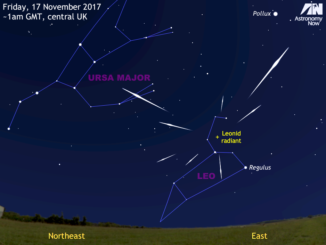
Early spring heralds the rise of the galaxies, when over the next three months or so the prime-time night sky is overflowing with a veritable treasure trove of bright and beautiful targets. Leo, the Lion, lies at the vanguard of this spring onslaught, offering as it does five Messier-designated galaxies and a handful of others that would wear the mantle comfortably.
Messier 95 and 96 are a very special pairing of photogenic spiral galaxies lying under a degree apart at the centre of Leo, about nine degrees east of Leo’s dominant star, magnitude +1.4 Regulus (alpha [α] Leonis). A small telescope will show the pair, while imagers can get great results, with wide-field shots having the substantial bonus of including Messier 105, a large and bright elliptical galaxy, in the field.

Track them down
At mid-March from London, Leo reaches the southern meridian at around 10pm GMT, with the M95/96 pairing culminating at around 11pm at a favourable 50-degree attitude. The pair can be comfortably observed for three hours or so either side of culmination; sweep for them with a small telescope some 4.5 degrees north-east of magnitude +3.9 rho (ρ) Leonis. M96 is the more easterly lying of the pair (M105 sits under a degree north-north-west of it), with M95 located 42 arcseconds west-south-west of its companion.

Similar numbers
They are remarkably similar in size and brightness, with Messier 96 (NGC 3368) being marginally the brighter than Messier 95 (NGC 3351), shining half a magnitude brighter at magnitude +9.2. M95 is slightly larger, with an apparent diameter of 7.4’ x 5.1’ as opposed to M96’s 7.1’ x 5.1’.
M96 is a spiral galaxy (morphology class SAB(rs)ab) with, in common with the vast majority of spiral galaxies, an elusive structure through a small telescope. It appears as circular diffuse patch of light through an 80mm (~three-inch) telescope at 40<M>x<M> power, while a 150mm (six-inch) reveals its core to be much brighter than the surrounding halo.
M95 sports a central bar (class SB(r)b) and is a superb-looking galaxy in deep amateur images. It’s appears diffuse than its companion through a small telescope, while an 80mm aperture can show a three-arcminute-wide glow, a tad larger than M96 offers. A 250-300mm (ten- to twelve-inch) telescope can reveal hints of M95’s bar under good conditions.




